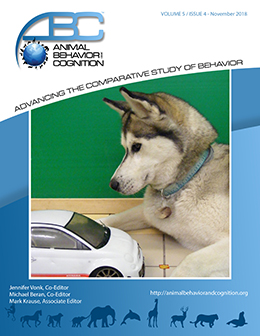Vol 5, Issue 4, November 2018
Effects of Anxiety on Canine Movement in Dog-Robot Interactions
Citation
Zamansky, A., Bleuer-Elsner, S., Masson, S., Amir, S., Magen, O., & van der Linden, D. (2018). Effects of anxiety on canine movement in dog-robot interactions. Animal Behavior and Cognition, 5(4), 380-387. https://doi.org/10.26451/abc.05.04.05.2018
Abstract
Canine behavioral disorders, such as various forms of fear and anxiety, are a major threat for the well-being of dogs and their owners. They are also the main cause for dog abandonment and relinquishment to shelters. Timely diagnosis and treatment of such problems is a complex task, requiring extensive behavioral expertise. Accurate classification of pathological behavior requires information on the dog's reactions to environmental stimuli. Such information is typically self-reported by the animal's owner, posing a threat to its accuracy and correctness. Simple robots have been used as controllable stimuli for evoking particular canine behaviors, leading to the increasing interest in dog-robot interactions (DRIs). We explore the use of DRIs as a tool for the assessment of canine behavioral disorders. More concretely, we ask in what ways disorders such as anxiety may be reflected in the way dogs interact with a robot. To this end, we performed an exploratory study, recording DRIs for a group of 20 dogs, consisting of 10 dogs diagnosed by a behavioral expert veterinarian with deprivation syndrome, a form of phobia/anxiety caused by inadequate development conditions, and 10 healthy control dogs. Pathological dogs moved significantly less than the control group during these interactions.
Keywords
Dog-robot interactions, DRI, Veterinary behavior, Canine anxiety
